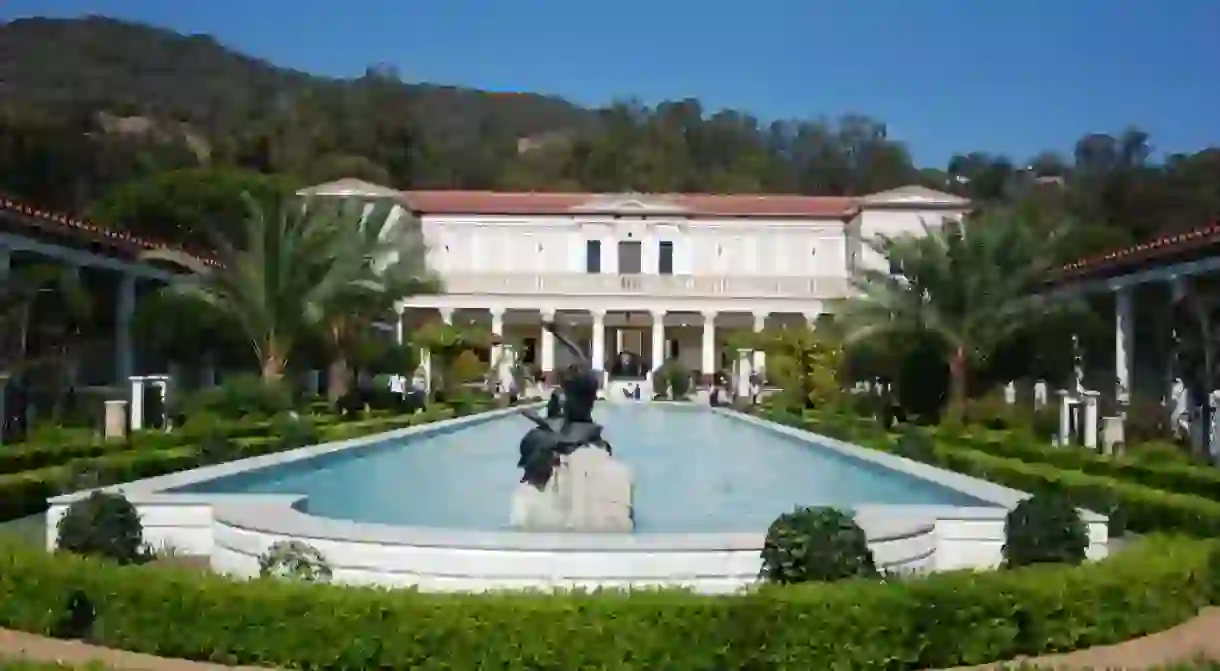The Getty Villa: A Penny-Pinching Billionaire’s Lavish Gift To The World

Despite being named ‘the wealthiest American and its only billionaire’ by Fortune magazine in 1957, oil magnate J. Paul Getty was a notorious skinflint, known for sayings like ‘if you look after the pennies, the dollars will look after themselves.’ But for all of his miserliness, he found great solace in art and left future generations access to his formidable collection at Los Angeles’s Getty Villa.
Known for his penny-saving habits, Getty famously installed a pay phone in one of his castle-like mansions because he suspected employees on the property were driving up his phone bill. Perhaps the most striking and well-publicized example of Getty’s miserliness came in 1973, when Italian gangsters kidnapped one of his grandsons; Getty refused to pay a cent until one of the boy’s ears was cut off as proof worse was yet to come. Finally, Getty negotiated the kidnappers down from ‘about $17 million to $2.2 million – just the amount that would be tax-deductible,’ and the young man was released.

Despite his unparalleled business prowess and the immense fortune Getty amassed, his personal life was turbulent – he had five different wives, two sons who predeceased him, and three other sons from whom he was estranged – but through his love of fine art and its collection, Getty apparently found solace. The appreciation and deep satisfaction he found when gazing on ancient masterpieces transported him to another world, and perhaps, to the heavens.

Art likely helped cool the fires of Getty’s domestic turmoil and momentarily relieved him from the burden of immense wealth. (His obituary in The New York Times noted, ‘Mr. Getty said he found himself lonely because so many people liked him for his bank balance while ignoring his other virtues.’) Meditating on the importance of art, Getty remarked: ‘The beauty one can find in art is one of the pitifully few real and lasting products of human endeavour. That beauty endures. A work of art lives . . . through the generations and centuries . . .’ Getty started buying art in the 1930s. He was fascinated with antiquities, and his collection of classical art soon grew to become one of the finest in the country.

Ultimately, visitors strolling through the aesthetically divine grounds and halls of the Getty Villa will find it difficult to reconcile tales of Getty’s insatiable money-grabbing with the generosity of his final wishes. Getty’s will, which calls for ‘the diffusion of artistic and general knowledge, led to the creation of the J. Paul Getty Trust, one of the largest supporters of visual arts in the world, with programs in exhibitions, conservation, research, and grantmaking.’ When conceiving his villa, which opened to the public in 1974, Getty wanted to make his collection of classical artworks accessible for all to see and wonder at – just as he once had.

Based on Herculaneum’s Villa dei Papiri, which was destroyed when Mount Vesuvius erupted in AD 79. As the Los Angeles Conservancy elegantly observed, ‘the result is unquestionably grand: a two-story building with a 300-foot-long peristyle of Doric and Corinthian columns surrounding a landscaped courtyard with a reflecting pool, Roman-style plantings, and bronze statues. Its interior galleries are likewise opulent, with fine stone wall finishes and shining terrazzo floors.’ When the Villa reopened after undergoing extensive renovations in 2006, The L.A. Times remarked, it ’embodied the passions of a notoriously tightfisted art collector who loved classical history and had dreams of grandeur.’

One of the most interesting statues at the Getty Villa is ‘The Landsdowne Herakles,’ a large marble Roman statue from about A.D. 125. The Getty Villa placard immediately in front identifies the piece as ‘one of J. Paul Getty’s most prized possessions [which] inspired him to build this Museum in the style of an ancient Roman villa.’

A scholarly work published by the Getty Villa and Seymour Howard in 1978 states, more definitively, that Getty ‘considered the Landsdowne Herakles as the most important antiquity in his museum. Besides the respectable history of the sculpture and its unquestioned artistic merit, Getty also had considerable affection for the hero Herakles himself.’ Taking a decidedly more cynical view of Getty’s attachment to the statue, the L.A. Times noted, ‘Getty bought [it] for a bargain $18,500 in 1951, when collecting antiquities was out of fashion.’

Whatever Getty’s motivations, lucky travelers and locals standing before the Landsdowne Herakles will come away awed by the statue’s timeless power and beauty – beauty that will, thanks to J. Paul Getty’s generous legacy, endure for the ages, as will the rest of the Villa’s vast collection and breathtaking grounds. Sitting on the edge of the Pacific Ocean, it is well worth the trip.
Timed-entry tickets should be reserved online. The $15 parking fee covers same-day parking at the Getty Center.













